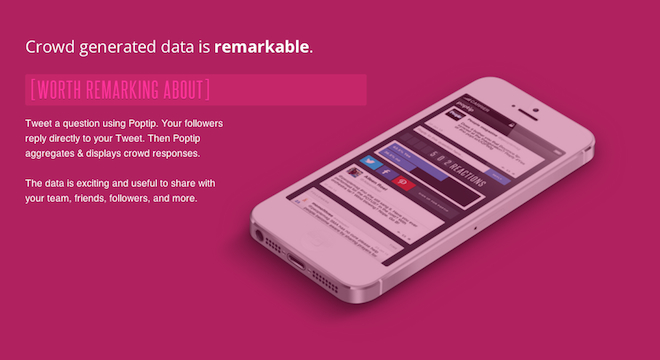Social media is a big draw for over 2.3 billion users around the globe, but its true value is only starting to be unlocked, according to Poptip, a New York-based startup company has seen early success running quick, realtime text analysis of tweets on Twitter as a kind of hi-tech snap polling method.
Mainstream companies from Pepsi to People Magazine to ESPN have begun experimenting with Poptip’s first and to date, only product, an app that allows users to post their questions on Twitter, then tracks and displays responses from respondents in realtime.
Poptip provides its users with an online dashboard where they can see the answers to their questions pouring in, along with a tally of the frequency of recurring words. Here’s an example screenshot of the dashboard for a question asked by Pepsi on Twitter on Wednesday:

The user can hold the poll up to 24 hours and close it any time before then. At any point during that time or afterward, a Poptip customer can share the results with the public, posting a link to their dashboard on Twitter, Facebook or Twitter to encourage more feedback and show users that their vote has been counted.
“It takes us 15 milliseconds to process a tweet as vote,” explained Poptip’s founder, Kelsey Falter, in a phone interview with TPM.
Poptip’s model isn’t designed to replace or compete with more standard, scientific polls — but rather give popular Twitter users the ability to rapidly take the temperature of their given audience.
“Our customers do not necessarily care what the global population thinks — that is what Nielsen and Gallop are for,” Falter wrote to TPM in an email. “What they care about is what their social following thinks.”
Darren Rovell, ESPN sports business reporter and an ABC News business correspondent, has been using snap polls to gauge his audience’s reaction on social media since 2009 — at one point tallying votes by hand.
But since he began using Poptip about six months ago, he’s never looked back.
“It’s the future,” Rovell told TPM of Poptip, “The fact that there is a polling system that’s out in the open, that people can see is legitimate, that their vote is being counted, and I don’t have to work for it by hand like I used to, it’s incredible.”
Rovell said he routinely asks questions on Poptip and uses the poll results in his coverage on ESPN and ABC News. He doesn’t use them unless 225 people have responded, but his average respondent rate is between 350 and 380 per question. One recent question about hoaxed college football star Manti Te’o pulled in 2,550 respondents.
Poptip questions can only be posted and tracked on Twitter for now, but Falter told TPM that the company plans to launch a Facebook text analysis program “by the end of February,” and Instagram analysis shortly thereafter.
Falter has also been impressed with Vine, Twitter’s new video creation and sharing app, and said that Poptip would “look into” launching an analysis tool for that app and social network if and when an API (application programming interface) becomes available for it.
“This is where the way world is moving,” Falter told TPM. “People want quick realtime takes on what’s happening right now, they want snapshots of information.”
As far as the accuracy of Poptip’s quick surveys, Falter said the margin of error was “only slightly higher than typical margin of error.”
“We’ve proven when multiple instances of the same question have been asked, [it] is around 6-7% between 38-600 votes,” Falter wrote in an email to TPM.
Falter sees Poptip as the next logical evolution in the growth of social media as a source of information and of generating business, especially for brands, merchants and media professionals.
“The first wave [of social media] was just getting followers,” Falter explained. “The second wave was when brands realized ‘holy crap, we’re spending money on platforms we don’t even track.’ The third wave was when brands were forced to become publishers, and that’s when you saw them launch blogs and create content specifically for social media. Now the wave is for companies to begin to incorporate crowd opinion and source crowd knowledge, to take the pulse.”
Poptip’s initial Twitter snap poll app is free to try out, but the company also offers paid accounts — around 10 paying customers so far — and is experimenting with other revenue strategies, as Falter told TPM.
“We have a number of sports teams using the product,” Falter said. “We’re working with them on the best ways to monetize the product.”
Falter said that one area the company and its customers are interested in is sponsored snap polls, where someone like a sports team could include the name of a paying sponsor company in a question they tweet out.
Altogether, the number of respondents to Poptip’s surveys have been in the “hundreds of thousands,” Falter said.
Poptip’s ultimate value may actually lie in the way it keeps track of the responses and respondents to questions. The company builds a unique profile of every respondent, keeping track of all of their answers to every question asked through the Poptip app. As a consequence, the company can create a detailed picture of respondents, including what they said about various products, accounts and issues.
“We can see if the people who responded to a NASCAR question also like Pepsi,” Falter noted. “We’re creating a holistic picture of your respondents.”
Poptip doesn’t yet make that data publicly available and is still figuring out the best way to do so, a way that’s “transparent and useful,” Falter said.
The small 8-person company, whose team includes a former Google engineer, launched in June as part of New York’s Techstars startup accelerator.
Correction: This article originally misquoted Falter as saying that Poptip’s text analysis took 15 seconds, when she in fact said “15 milliseconds.” We apologize for the error and have since corrected it in copy.






